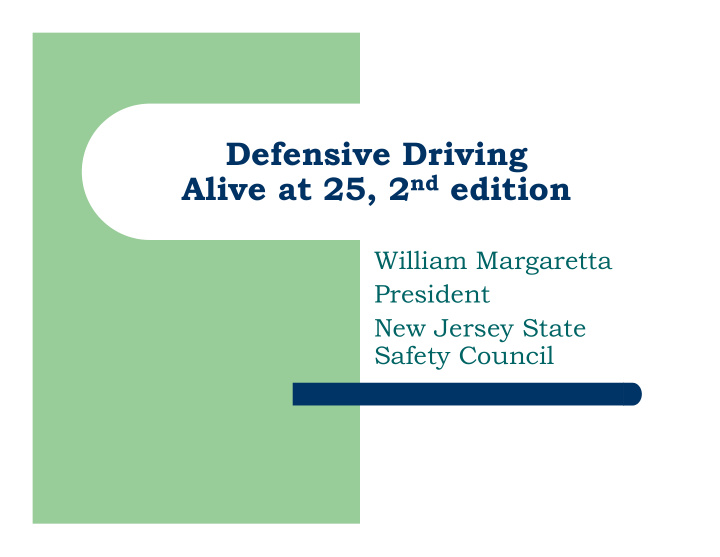



Defensive Driving Alive at 25, 2 nd edition William Margaretta President New Jersey State Safety Council
Program Overview � Long Term Goal : To reduce the number of violations, injuries and fatalities incurred by young drivers between the ages of 16 and 24. � Focus : To persuade young drivers to take responsibility for their behaviors and to adopt safer driving habits � Course Length : Four Hours
Characteristics of Young Adults � Are independent thinkers and have a need to make their own decisions � Feel they should be treated as adults � Question the rules, values, actions and restrictions of their parents � Rely more on each other for support � Test boundaries and take risks � Are more concerned about the here and now than long term effects of an action � Feel invulnerable � Deal with feelings more effectively when they can say what they feel without having and adult overreact.
The Program is Designed to be Facilitated not Taught � DDC-Alive at 25 is a highly interactive young driver intervention program in which the instructor plays the role of facilitator. � Using workbook exercises, interactive video segments, small group discussion, role playing and short lectures you help young drivers develop convictions and strategies that will keep them safer on the road.
There are Four Sessions � Session 1: Why are We at Risk? � Session 2: You be the Judge. � Session 3: Taking Control. � Session 4: Taking Charge!
1. Why Are We At Risk � Get acquainted with other participants � Face the collision and fatality statistics for this age group � Discuss why young drivers have such high violation rates and how driving behaviors and attitudes contribute � See how inexperience, peer pressure, distraction, and underestimation of risk cause unique driving hazards.
2. You Be The Judge � Watch Real Streets three video case studies of youthful drivers facing difficult situations. � Discuss unsafe driving practices, pressures, and driving laws broken in each. � Review defensive driving principles � Understand how hazards, impaired driving, speeding, distractions, fatigue and not wearing a seat belt increase risk. � Use Defensive Driving strategies to set personal guidelines and guidelines for others.
3. Taking Control � Identify situations that lead to feeling out of control as a driver. � Analyze eight hazardous situations and discuss how to use Defensive Driving strategies to take control in each � Formulate what to say to peers who are trying to take control, whether as a driver or passenger � Conclude that a real leader drives safely and responsibly
4. Taking Charge! � Become acquainted with State and local driving laws and regulations � Explore instances where other young drivers lost control and role-play ways to take charge � Watch Real People, a video in which young drivers share their personal accounts of living with disabling injuries � Commit to making a change in driving attitudes and behaviors.
Alive at 25 Changes the Behavior of Young Drivers, Because of Skill Practice. � It is learner-centered rather than teacher centered. � Provides experience before facing a potentially dangerous, real life situation � Allows young drivers to formulate what to say ahead of time and builds confidence in effectively delivering the message. � Helps develop new behaviors. � Encourages broadening perspectives and seeing other points of view.
Alive at 25 Research � Northwestern University Traffic Institute in a series of focus groups, of participants aged 16 to 24 who had attended a program found : � Participants liked instructors who – Were non threatening and non punitive – Did not condescend – Used a sense of humor – Initiated class discussions
Alive at 25 Research � Participants did not like instructors who – Were reprimanding and punitive – Acted like perfect drivers – Could not relate to the group – Read from the book – Relied on lectures
Alive at 25 Research � A recent study of the Colorado State Patrol showed that the while the national fatality rate for this age group is nearly 13 per 20,000. Currently, Alive at 25 graduates have a fatality rate of 1.1 per 20,000 That is 90% less than the national average. � Colorado dropped their under age 20 fatal rate in 2005 by 50%
Instructor Development � The course is taught by only certified instructors to ensure that the material is consistently presented at the high level of quality the National Safety Council represents. � The materials are leased and there for updated regularly. � All instructors get access to NSC instructor information
Adding the Parents to the Equation � NSC Developed “Teen Driver – A Family Guide to Teen Driver Safety” � Developed after 10 years of peer reviewed research it is a Family Risk Reduction Manual � It covers the High Risks, The Good and Bad Behaviors, and gives very practical advice to parents on being a good guide for the “soon to be” young driver.
A New Paradigm � When done together the effect is powerful. � The teens get live saving information. � The parents are “empowered” and become partners with the school, law enforcement and the legislative and regulatory agencies. � Parents all get the same messages providing support for them to set and stick to parental rules to supplement GDL requirements.
Recommend
More recommend